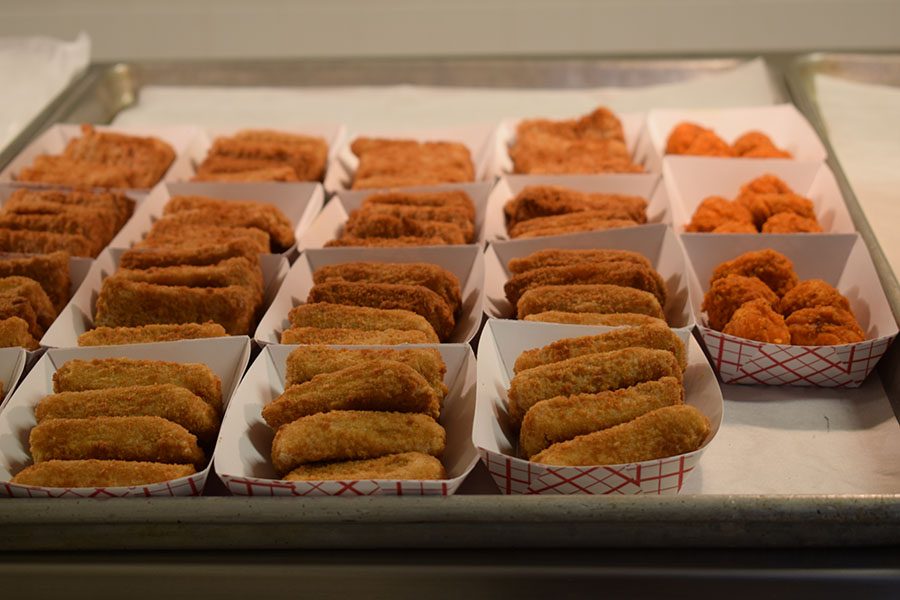Behind the Cafeteria Counter: Inside Look at School Lunches
Mozzarella sticks laid out as one of a variety of lunch options for students. Cafeteria managers are required to serve certain daily specials, though they have the flexibility to offer additional options.
March 6, 2019
About one third of RHS students eat school-provided lunch every day, yet many are unaware of what goes on behind the scenes to prepare their meals.
All MCPS elementary, middle and high schools offer both lunch and breakfast meals to students with a varied menu. The MCPS Division of Food and Nutrition Services (DFNS) oversees all ordering, processing and inspecting of food health facilities and school-provided meals, ensuring all students have a meal to eat.
Of the students who eat school lunch daily, a significant number qualify for free or reduced meals (FARMS), and in order to combat various food insecurity issues for MCPS students, a Dine with Dignity program has been introduced.
Montgomery County’s food insecurity rate has steadily been decreasing, yet it is still a prevalent issue, especially for low-income children, according to a 2016 Feeding America poll by Healthy Montgomery. Over 30 percent of RHS students, according to the 2017-18 Schools at a Glance report, qualify for FARMS.
For this reason, the availability of at least two guaranteed meals a day is necessary to ensure student performance. A 2018 study of Appalachian University students conducted by West Virginia University (WVU) PhD candidate Rebecca Hagedorn and Associate Professor Melissa Olfert, found that health status increased with better food security.
In MCPS, DFNS creates monthly meal schedules and then sends them out to school cafeteria managers who follow the guidelines. Menus are planned by 10 DFNS nutritionists who meet every month, and an online ordering system is used for school cafeteria managers to place orders.
“To ensure menus reflect student preferences, direct input from cafeteria managers and students is received from focus groups and taste testings of new or planned menu items,” DFNS Director Susan McCarron said.
Food items served in meals must meet state and federal requirements as set by the Healthy Hunger Free Kids Act of 2010, McCarron said. Recently, MCPS has undertaken new initiatives to increase school lunch quality such as by purchasing more local produce, increasing vegan and vegetarian selections and adding more fruits and vegetables to the menus.
“Food items, such as pizza, hamburgers, yogurt and milk must meet nutritional guidelines while whole grains, fresh fruits and vegetables and lower fat and sodium foods are emphasized,” McCarron said.
Cafeteria managers are required to serve certain daily specials, yet are given discretion in the quantity served and the other options available.
“They give some flexibility in the menu so that each school kind of varies, like [at] some schools the curry chicken does very well and they end up making forty portions or eighty portions, while at other schools you might make only six, ” RHS cafeteria manager Alexandra Phillips said. “So it varies from school to school but…we do have to follow whatever the options are on the menu for that day.”
Special orders from each school are handed up to the DFNS supervisor who completes all bulk orders. DFNS processes all orders and oversees the delivery from their warehouse to the schools.
Phillips says she orders based on student preferences, so foods that are taken and eaten more often get ordered in higher bulk. The most popular foods at RHS are macaroni and cheese, the round pizzas and the dippers, Phillips said.
Phillips and the cafeteria team also are required to log every inventory such as food and meals ordered as compared to how much was eaten in order to gauge food popularity. Cafeteria staff also record exact temperatures of food as they are taken out of the oven. Specific DFNS regulations require most hot food be cooked to 160 degrees.
Health inspections are carried out twice a year by an external inspector hired by DFNS. So far, RHS has not received any health code violations.
“I buy lunch every day and for the most part it is good. I usually only get dry items except for nachos. I’m not sure where the food comes from so I try not to eat things that look ‘suspicious.’ Sometimes the food is too dry or the french fries taste like they weren’t freshly made. I wish I knew more about what I was eating but unfortunately I don’t,” junior Gabriella Togue said.
MCPS’ Dine with Dignity program, launched in November 2018, was in response to the July 1 Maryland Cares for Kids Act which works to alleviate the price of reduced meals. The program is expected to receive full funding by 2023, but Dine with Dignity is a way for students to receive the benefits before then.
“The Foundation supports a program that would allow students to receive the lunch of their choice, and also would work with parents to: a) explain the importance of nutrition in academic achievement; b) help the parent to apply for Free and Reduced-priced Meal System (FARMS) if the family qualifies; c) work with parents who do not qualify for free meals to make a contribution within their means toward the arrears balance of the account,” according to the MCPS Educational Foundation Inc. website.
In the meantime, RHS cafeteria workers and DFNS continue to work diligently to provide students with filling meals to prepare them for class. While precautions are taken to avoid waste, any hot items already prepared that are not eaten, must be thrown away.
“I hope people are happy with the quality that we provide and they are welcome to return something if they think it is too dry or too this or too that,” Phillips said. “We’ll look and see whether there is anything that can be done.”





